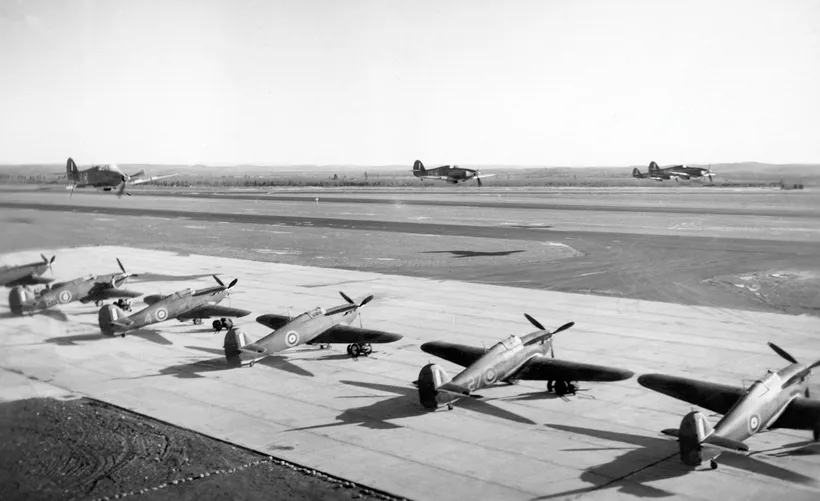Bellhouse, Reginald (Flight Sergeant)
Killed in Flying Accident 1944-November-16


Birth Date: 1922
Born:
Parents: Son of Frank Gordon and Emily Elizabeth Bellhouse, of Mount Macedon, Victoria, Australia.
Spouse:
Home:
Enlistment:
Enlistment Date: unkown date
Service
RAAF
Unit
1 OTU- Operational Training Unit
Base
RCAF Stn. Greenwood, Nova Scotia
Rank
Flight Sergeant
Position
Service Numbers
436712
This incident involved multiple aircraft:
- Hurricane Mk. XII Serial: 5437
- Hurricane Mk. XII Serial: 5715
All the above aircraft in the above list are referenced in this report.
Accident Card - Hawker Hurricane Mk. XII serial:5715
This accident involved 2 aircraft on 1944-November-16. They are: Hawker Hurricane XII s/n 5437, Hawker Hurricane XII s/n 5715.
This accident involved 2 people. Bellhouse R, O'Hanlon PF
This accident had 2 fatalities. Flight Sergeant Reginald Bellhouse RAAF Killed in Flying Accident service no:436712 Hurricane 5715,Pilot Officer P F O'Hanlon RAF Killed in Flying Accident service no: Hurricane 5437
Hurricane serial: 5715

Source BBMF
The Hawker Hurricane is a single-seat fighter aircraft of the 1930s"“1940s that was designed and predominantly built by Hawker Aircraft Ltd. for service with the Royal Air Force (RAF). The Hurricane developed through several versions, as bomber-interceptors, fighter-bombers, and ground support aircraft in addition to fighters. Versions designed for the Navy were popularly known as the Sea Hurricane, with modifications enabling their operation from ships. Some were converted to be used as catapult-launched convoy escorts. By the end of production in July 1944, 14,487 Hurricanes had been completed in Britain and Canada.
A major manufacturer of the Hurricane was Canadian Car and Foundry at their factory in Fort William (now Thunder Bay), Ontario. The facility's chief engineer, Elsie MacGill, became known as the "Queen of the Hurricanes". The initiative was commercially led rather than governmentally, but was endorsed by the British government; Hawker, having recognized that a major conflict was all but inevitable after the Munich Crisis of 1938, drew up preliminary plans to expand Hurricane production via a new factory in Canada. Under this plan, samples, pattern aircraft, and a complete set of design documents stored on microfilm, were shipped to Canada; the RCAF ordered 20 Hurricanes to equip one fighter squadron and two more were supplied to Canadian Car and Foundry as pattern aircraft but one probably did not arrive. The first Hurricane built at Canadian Car and Foundry was officially produced in February 1940. As a result, Canadian-built Hurricanes were shipped to Britain to participate in events such as the Battle of Britain. Canadian Car and Foundry (CCF) was responsible for the production of 1,451 Hurricanes. Wikipedia and Harold A Skaarup Web Page
Aircraft Images
Hurricane 5437
Hurricane Mk. XII 5437
Delivered to Eastern Air Command, for use at No. 1 (F) Operational Training Unit at RCAF Station Bagotville, Quebec. To Eastern Air Command, Home War Establishment on 27 October 1943. To stored reserve with EAC 15 January 1944. Back to No. 1 (F) OTU on 4 February 1944. Category A crash at 15:30 on 16 November 1944, reported by No. 1 Advanced Tactical Training Detachment at RCAF Station Greenwood, NS. Crashed 2 miles from Kentville, NS. Collided with Hurricane 5715, at 12:15. This aircraft came down on farm owned by Wilson Shafer, near Gaspereau Lake, disposed of on site. Mr. Shafer supplied a horse and wagon to remove large pieces of wreckage. Ownership of other remains this aircraft, and Hurricane 5715, passed to Mr. Fairn by Crown Assets Disposal Corporation on 12 July 1983, free of charge. Only small pieces of 5437 remained at the crash site by then.1942-08-19 Taken on Strength 2019-08-20
1943-May-05 Accident: 1 Operational Training Unit Loc: Saint-Honore Quebec Names: Ernst
1944-November-16 Accident: 1 ATT DETACH Loc: Kentville Names: Bellhouse | O'Hanlon
1944-12-15 Struck off Strength 2019-08-20
Hurricane 5715
Hurricane Mk. XII 5715
Delivered to stored reserve pending delivery of radiators, issued from storage to the Home War Establishment on 7 August 1943. Category "C" crash on 26 November 1943, while being operated by No. 126 (F) Squadron. While lining for a formation take-off, the pilot of Hurricane #5664 over-controlled and swung into #5715 which was stationary. Lent to BCATP (British Commonwealth Air Training Plan) from 7 April 1944. Category "A" crash 15:30 on 16 November 1944, reported by No. 1 Advanced Tactical Training Detachment at RCAF Station Greenwood, Nova Scotia. Crashed 2 miles south of Kentville, Nova Scotia. Collided with Hurricane #5437, at 12:15 local time. This aircraft came down in Gaspereau Lake, wreckage not recovered at the time. Sgt. R. Bellhouse, RAAF, killed in this aircraft. Wreckage recovered in the mid 1980s, over several summers, by Les Fairn of Edmonton, Alberta. Ownership of this aircraft, and Hurricane 5437, passed to Mr. Fairn by Crown Assets disposal Corporation on 12 July 1983, free of charge. Later sold to J. Arnold of Brantford, Ontario. Reported sold to Californian owner later, parts used to rebuild another Hurricane.1943-01-08 Taken on Strength Eastern Air Command 2019-08-20
1944-November-16 Accident: 1 ATT DETACH Loc: Kentville Names: Bellhouse | O'Hanlon
1944-11-16 Accident Category A 2022-02-10
1944-12-15 Struck off Strength written off 2022-02-10
Unit Desciption
1 OTU (1 Operational Training Unit)
The Operational Training Unit (OTU) was the last stop for aircrew trainees. They spent 8 to 14 weeks learning to fly operational aircraft (Hawker Hurricane or Fairey Swordfish, e.g.). The instructors had experience in actual operations, and often were posted to OTUs after their operational tour.